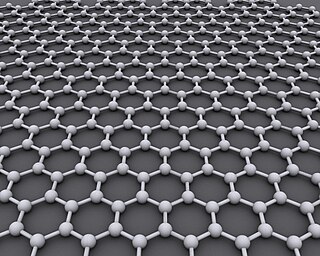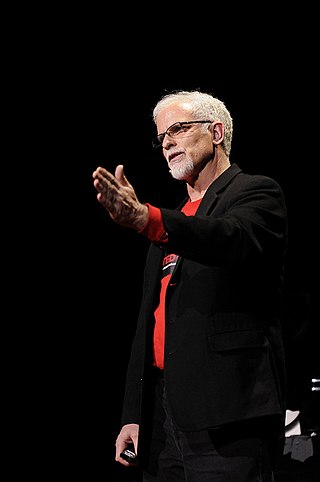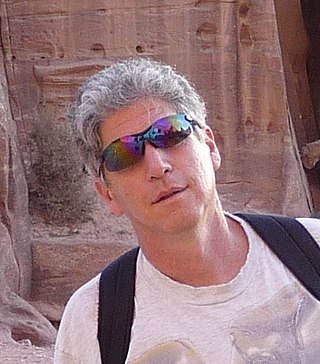Related Research Articles

A perovskite is any material with a crystal structure following the formula ABX3, which was first discovered as the mineral called perovskite, which consists of calcium titanium oxide (CaTiO3). The mineral was first discovered in the Ural mountains of Russia by Gustav Rose in 1839 and named after Russian mineralogist L. A. Perovski (1792–1856). 'A' and 'B' are two positively charged ions (i.e. cations), often of very different sizes, and X is a negatively charged ion (an anion, frequently oxide) that bonds to both cations. The 'A' atoms are generally larger than the 'B' atoms. The ideal cubic structure has the B cation in 6-fold coordination, surrounded by an octahedron of anions, and the A cation in 12-fold cuboctahedral coordination. Additional perovskite forms may exist where either/both the A and B sites have a configuration of A1x-1A2x and/or B1y-1B2y and the X may deviate from the ideal coordination configuration as ions within the A and B sites undergo changes in their oxidation states.

In physics, polaritons are quasiparticles resulting from strong coupling of electromagnetic waves with an electric or magnetic dipole-carrying excitation. They are an expression of the common quantum phenomenon known as level repulsion, also known as the avoided crossing principle. Polaritons describe the crossing of the dispersion of light with any interacting resonance. To this extent polaritons can also be thought of as the new normal modes of a given material or structure arising from the strong coupling of the bare modes, which are the photon and the dipolar oscillation. The polariton is a bosonic quasiparticle, and should not be confused with the polaron, which is an electron plus an attached phonon cloud.

Graphene is an allotrope of carbon consisting of a single layer of atoms arranged in a hexagonal lattice nanostructure. The name is derived from "graphite" and the suffix -ene, reflecting the fact that the graphite allotrope of carbon contains numerous double bonds.
Sir Mark Edward Welland, is a British physicist who is a professor of nanotechnology at the University of Cambridge and head of the Nanoscience Centre. He has been a fellow of St John's College, Cambridge, since 1986 and started his career in nanotechnology at IBM Research, where he was part of the team that developed one of the first scanning tunnelling microscopes. He was served as the Master of St Catharine's College, Cambridge and took up office from 2016 to 2023.
Multiferroics are defined as materials that exhibit more than one of the primary ferroic properties in the same phase:
Scanning probe lithography (SPL) describes a set of nanolithographic methods to pattern material on the nanoscale using scanning probes. It is a direct-write, mask-less approach which bypasses the diffraction limit and can reach resolutions below 10 nm. It is considered an alternative lithographic technology often used in academic and research environments. The term scanning probe lithography was coined after the first patterning experiments with scanning probe microscopes (SPM) in the late 1980s.

Lanthanum strontium manganite (LSM or LSMO) is an oxide ceramic material with the general formula La1−xSrxMnO3, where x describes the doping level.

Peter Brent Littlewood, FRS is a British physicist and Professor of Physics at the University of Chicago. He was the 12th Director of Argonne National Laboratory. He previously headed the Cavendish Laboratory as well as the Theory of Condensed Matter group and the Theoretical Physics Research department at Bell Laboratories. Littlewood serves as the founding chair of the board of trustees of the Faraday Institution.

Nicholas Harrison FRSC FinstP is an English theoretical physicist known for his work on developing theory and computational methods for discovering and optimising advanced materials. He is the Professor of Computational Materials Science in the Department of Chemistry at Imperial College London where he is co-director of the Institute of Molecular Science and Engineering.
Jeroen van den Brink is a theoretical condensed matter physicist, director at the Leibniz Institute for Solid State and Materials Research, IFW Dresden and professor at the Dresden University of Technology in Germany. Van den Brink is known for contributions to the field of strongly correlated materials, in particular for proposals on magnetic and orbital ordering, mechanisms for multiferroicity and the theory of Resonant Inelastic X-Ray Scattering (RIXS).

Michael Lee Roukes is an American experimental physicist, nanoscientist, and the Frank J. Roshek Professor of Physics, Applied Physics, and Bioengineering at the California Institute of Technology (Caltech).

Yigal Meir is the Graham Beck professor of Quantum Science and Technology at Ben Gurion University, specializing in condensed matter; in particular mesoscopic physics, disordered systems and strongly correlated materials. Among his achievements is the derivation of the Meir-Wingreen Formula, and solving the 0.7 anomaly puzzle in quantum point contacts.

Paul Anthony Midgley FRS is a Professor of Materials Science in the Department of Materials Science and Metallurgy at the University of Cambridge and a fellow of Peterhouse, Cambridge.

Kwang Soo Kim is a South Korean professor in chemistry, an adjunct professor in physics, and the director of Center for Superfunctional Materials (CSM), of Ulsan National Institute of Science and Technology (UNIST) in South Korea. He received his B.S. and M.S. degrees in Applied Chemistry from Seoul National University and also an M.S. degree in Physics from Korea Advanced Institute of Science and Technology (KAIST) (1975). He obtained his Ph.D. degree from University of California, Berkeley (1982). His research fields include Theoretical/Computational Chemistry/Physics and Experimental Nanosciences.
Akhoury Purnendu Bhusan Sinha was an Indian solid state chemist who was the head of the Physical Chemistry Division of the National Chemical Laboratory, Pune. He is known for his theories on semiconductors and his studies on synthesis of manganites. He was an elected fellow of the Indian National Science Academy and the Indian Academy of Sciences. The Council of Scientific and Industrial Research, the apex agency of the Government of India for scientific research, awarded Sinha the Shanti Swarup Bhatnagar Prize for Science and Technology, one of the highest Indian science awards, in 1972, for his contributions to chemical sciences.
Lesley Francis Cohen is a Professor of solid-state physics at Imperial College London. She works in magnetic materials for solid-state magnetic refrigeration and spintronic applications. Cohen has served as the editor-in-chief of Applied Physics Letters since 2019.

Mordehai "Moty" Heiblum is an Israeli electrical engineer and condensed matter physicist, known for his research in mesoscopic physics.

Jeremy Levy is an American physicist who is a Distinguished Professor of Physics at the University of Pittsburgh.
Pritiraj Mohanty is a physicist and entrepreneur. He is a professor of physics at Boston University. He is most known for his work on quantum coherence, mesoscopic physics, nanomechanical systems, and nanotechnology with a recent focus on biosensing and nanomechanical computing.
Elbio Rubén Dagotto is an Argentinian-American theoretical physicist and academic. He is a distinguished professor in the department of physics and astronomy at the University of Tennessee, Knoxville, and Distinguished Scientist in the Materials Science and Technology Division at the Oak Ridge National Laboratory.
References
- ↑ Cambridge University Reporter, 4 October 2000
- ↑ Anon (2014). "Neil Mathur: Investigator Profiles". University of Cambridge. Archived from the original on 13 April 2014.
- ↑ Hueso, L. E.; Pruneda, J. M.; Ferrari, V; Burnell, G; Valdés-Herrera, J. P.; Simons, B. D.; Littlewood, P. B.; Artacho, E; Fert, A; Mathur, N. D. (2007). "Transformation of spin information into large electrical signals using carbon nanotubes". Nature. 445 (7126): 410–3. Bibcode:2007Natur.445..410H. doi:10.1038/nature05507. hdl: 11336/96240 . PMID 17251975. S2CID 4400218.
- ↑ Garcia, V; Fusil, S; Bouzehouane, K; Enouz-Vedrenne, S; Mathur, N. D.; Barthélémy, A; Bibes, M (2009). "Giant tunnel electroresistance for non-destructive readout of ferroelectric states". Nature. 460 (7251): 81–4. Bibcode:2009Natur.460...81G. doi:10.1038/nature08128. PMID 19483675. S2CID 4339829.
- ↑ Loudon, J. C.; Mathur, N. D.; Midgley, P. A. (2002). "Charge-ordered ferromagnetic phase in La0.5Ca0.5MnO3". Nature. 420 (6917): 797–800. arXiv: cond-mat/0209436 . Bibcode:2002Natur.420..797L. doi:10.1038/nature01299. PMID 12490944. S2CID 4382641.
- ↑ Mathur, N.; Littlewood, P. (2003). "Mesoscopic texture in manganites". Physics Today. 56 (1): 25–30. Bibcode:2003PhT....56a..25M. doi:10.1063/1.1554133.
- ↑ Mathur, N.; Littlewood, P. (2004). "Nanotechnology: The third way". Nature Materials. 3 (4): 207–209. Bibcode:2004NatMa...3..207M. doi:10.1038/nmat1108. PMID 15085858. S2CID 34783620.